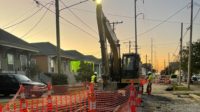If another Hurricane Katrina-like disaster hits New Orleans, the city’s water and sewer board will now have a hazard-mitigation plan to ensure that local environmental infrastructure can get state and federal emergency repair funds.
“Probably a lot of other cities don’t have this because they haven’t had the disaster,” says Gordon Austin, chief of environmental affairs for the New Orleans Sewerage and Water Board. “This is a formality to make sure you’re eligible for [Federal Emergency Management Agency] mitigation funds.”
The board still is trying to obtain FEMA funding to mitigate an estimated $98 million in damage from Katrina, which struck in 2005. According to Austin, San Francisco waited a decade after the 1989 Loma Prieta earthquake for FEMA reimbursement, and Florida waited at least 15 years for funds after Hurricane Andrew in 1992.
Because the New Orleans board did not have its own hazard-mitigation plan, one that classifies it as a single local jurisdiction, the infrastructure provider had to compete for funding with fire and police departments and other city agencies.
By developing a plan that complies with rules for receiving hazard-mitigation funding, the board’s jurisdiction is recognized, and it can apply directly for FEMA grant programs and reimbursements, says Tom Miller, a board staff member.
Austin adds that having FEMA pre-approve specific mitigations speeds up the process. “It makes sure you are aware of potential hazards and that you are actually identifying need,” he points out. Prior to Katrina, because the board had not failed to provide service in more than 100 years, it had underestimated risks of events such as Katrina, Austin concedes.
Lambert Engineers, New Orleans, which developed the board mitigation plan under a $43,200 contract, vetted it at hearings. The board anticipates state and FEMA approval by April 11. The final version will be at www.swbno.org. Federal rules require updates every five years.



